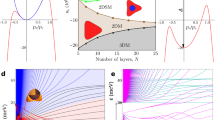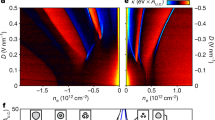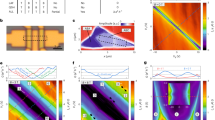Abstract
To access superconductivity via the electric field effect in a clean, two-dimensional device is a central goal of nanoelectronics. Recently, superconductivity has been realized in graphene moiré heterostructures1,2,3,4; however, many of these structures are not mechanically stable, and experiments show signatures of strong disorder. Here we report the observation of superconductivity—manifesting as low or vanishing resistivity at sub-kelvin temperatures—in crystalline rhombohedral trilayer graphene5,6, a structurally metastable carbon allotrope. Superconductivity occurs in two distinct gate-tuned regions (SC1 and SC2), and is deep in the clean limit defined by the ratio of mean free path and superconducting coherence length. Mapping of the normal state Fermi surfaces by quantum oscillations reveals that both superconductors emerge from an annular Fermi sea, and are proximal to an isospin-symmetry-breaking transition where the Fermi surface degeneracy changes7. SC1 emerges from a paramagnetic normal state, whereas SC2 emerges from a spin-polarized, valley-unpolarized half-metal17 and violates the Pauli limit for in-plane magnetic fields by at least one order of magnitude8,9. We discuss our results in view of several mechanisms, including conventional phonon-mediated pairing10,11, pairing due to fluctuations of the proximal isospin order12, and intrinsic instabilities of the annular Fermi liquid13,14. Our observation of superconductivity in a clean and structurally simple two-dimensional metal provides a model system to test competing theoretical models of superconductivity without the complication of modelling disorder, while enabling new classes of field-effect controlled electronic devices based on correlated electron phenomena and ballistic electron transport.
This is a preview of subscription content, access via your institution
Access options
Access Nature and 54 other Nature Portfolio journals
Get Nature+, our best-value online-access subscription
$29.99 / 30 days
cancel any time
Subscribe to this journal
Receive 51 print issues and online access
$199.00 per year
only $3.90 per issue
Buy this article
- Purchase on Springer Link
- Instant access to full article PDF
Prices may be subject to local taxes which are calculated during checkout




Similar content being viewed by others
Data availability
The data that support the findings of this study are available from the corresponding authors on reasonable request.
References
Cao, Y. et al. Unconventional superconductivity in magic-angle graphene superlattices. Nature 556, 43–50 (2018).
Chen, G. et al. Signatures of tunable superconductivity in a trilayer graphene moiré superlattice. Nature 572, 215–219 (2019).
Park, J. M., Cao, Y., Watanabe, K., Taniguchi, T. & Jarillo-Herrero, P. Tunable strongly coupled superconductivity in magic-angle twisted trilayer graphene. Nature 590, 249–255 (2021).
Hao, Z. et al. Electric field–tunable superconductivity in alternating-twist magic-angle trilayer graphene. Science 371, 1133 (2021).
Koshino, M. & McCann, E. Trigonal warping and Berry’s phase Nπ in ABC-stacked multilayer graphene. Phys. Rev. B 80, 165409 (2009).
Zhang, F., Sahu, B., Min, H. & MacDonald, A. H. Band structure of ABC-stacked graphene trilayers. Phys. Rev. B 82, 035409 (2010).
Zhou, H. et al. Half and quarter metals in rhombohedral trilayer graphene. Preprint at https://arxiv.org/abs/2104.00653 (2021).
Clogston, A. M. Upper limit for the critical field in hard superconductors. Phys. Rev. Lett. 9, 266–267 (1962).
Chandrasekhar, B. S. A note on the maximum critical field of high-field superconductors. Appl. Phys. Lett. 1, 7–8, (1962).
Bardeen, J., Cooper, L. N. & Schrieffer, J. R. Theory of superconductivity. Phys. Rev. 108, 1175–1204 (1957).
Gor’kov, L. P. Superconducting transition temperature: interacting Fermi gas and phonon mechanisms in the nonadiabatic regime. Phys. Rev. B 93, 054517 (2016).
Scalapino, D. J. A common thread: the pairing interaction for unconventional superconductors. Rev. Mod. Phys. 84, 1383–1417 (2012).
Kohn, W. & Luttinger, J. M. New mechanism for superconductivity. Phys. Rev. Lett. 15, 524–526 (1965).
Chubukov, A. V. & Kivelson, S. A. Superconductivity in engineered two-dimensional electron gases. Phys. Rev. B 96, 174514 (2017).
Cooper, L. N. Bound electron pairs in a degenerate Fermi gas. Phys. Rev. 104, 1189–1190 (1956).
Stoner, E. C. Collective electron ferromagnetism. Proc. R. Soc. A 165, 372–414 (1938).
Mathur, N. D. et al. Magnetically mediated superconductivity in heavy fermion compounds. Nature 394, 39–43 (1998).
Lee, Y. et al. Gate tunable magnetism and giant magnetoresistance in ABC-stacked few-layer graphene. Preprint at https://arxiv.org/abs/1911.04450 (2019).
Shi, Y. et al. Electronic phase separation in multilayer rhombohedral graphite. Nature 584, 210–214 (2020).
Castro, E. V., Peres, N. M. R., Stauber, T. & Silva, N. A. P. Low-density ferromagnetism in biased bilayer graphene. Phys. Rev. Lett. 100, 186803 (2008).
Berezinsky, V. L. Destruction of long range order in one-dimensional and two-dimensional systems having a continuous symmetry group. I. Classical systems. Sov. Phys. JETP 32, 493–500 (1971).
Kosterlitz, J. M. & Thouless, D. J. Ordering, metastability and phase transitions in two-dimensional systems. J. Phys. C 6, 1181–1203 (1973).
Anderson, P. W. Theory of dirty superconductors. J. Phys. Chem. Solids 11, 26–30 (1959).
Abrikosov, A. A. & Gor'kov, L. P. Contribution to the theory of superconducting alloys with paramagnetic impurities. Zhur. Eksptl'. i Teoret. Fiz. 39, 1782–1796 (1960).
Tinkham, M. Introduction to Superconductivity 2nd edn (McGraw-Hill, New York, 1975).
Wang, L. et al. One-dimensional electrical contact to a two-dimensional material. Science 342, 614–617 (2013).
Taychatanapat, T., Watanabe, K., Taniguchi, T. & Jarillo-Herrero, P. Electrically tunable transverse magnetic focusing in graphene. Nat. Phys. 9, 225–229 (2013).
Lee, M., Wallbank, J. R., Gallagher, P., Watanabe, K., Taniguchi, T., Fal’ko, V. I. & Goldhaber-Gordon, D. Ballistic miniband conduction in a graphene superlattice. Science 353, 1526–1529 (2016).
Lee, J. Y. et al. Theory of correlated insulating behaviour and spin-triplet superconductivity in twisted double bilayer graphene. Nat. Comm. 10, 5333 (2019).
Cornfeld, E., Rudner, M. S. & Berg, E. Spin-polarized superconductivity: order parameter topology, current dissipation, and multiple-period Josephson effect. Phys. Rev. Research 3, 013051 (2021).
Löthman, T. & Black-Schaffer, A. M. Universal phase diagrams with superconducting domes for electronic flat bands. Phys. Rev. B 96, 064505 (2017).
Ojajärvi, R., Hyart, T., Silaev, M. A. & Heikkilä, T. T. Competition of electron-phonon mediated superconductivity and Stoner magnetism on a flat band. Phys. Rev. B 98, 054515 (2018).
Gor’kov, L. P. Phonon mechanism in the most dilute superconductor SrTiO3. Proc. Natl. Acad. Sci. USA 113, 4646 (2016).
Kopnin, N. B., Heikkilä, T. T. & Volovik, G. E. High-temperature surface superconductivity in topological flat-band systems. Phys. Rev. B 83, 220503 (2011).
McMillan, W. L. Transition temperature of strong-coupled superconductors. Phys. Rev. 167, 331–344 (1968).
Poole C. P. Jr., Zasadzinski, J. F., Zasadzinski, R. K., & Allen, P. B., Handbook of Superconductivity Ch. 9, 433-489, edited by Poole, C. P. Jr (Academic Press, 2000).
Masubuchi, S., Ono, M., Yoshida, K., Hirakawa, K. & Machida, T. Fabrication of graphene nanoribbon by local anodic oxidation lithography using atomic force microscope. Appl. Phys. Lett. 94, 082107 (2009).
Li, H. et al. Electrode-free anodic oxidation nanolithography of low-dimensional materials. Nano Lett. 18, 8011–8015 (2018).
Acknowledgements
The authors acknowledge extensive discussions with E. Berg and M. Zaletel and thank them for their comments on the completed manuscript. The authors also acknowledge discussions with S. Kivelson, S. Das Sarma, A. Bernevig and A. H. Macdonald. We acknowledge experimental assistance from L. Cohen, who installed the dilution refrigerator. This project was primarily funded by the United States Department of Energy under DE-SC0020043. A.F.Y. acknowledges the support of the Gordon and Betty Moore Foundation under award GBMF9471. K.W. and T.T. acknowledge support from the Elemental Strategy Initiative conducted by the MEXT, Japan (grant number JPMXP0112101001) and JSPS KAKENHI (grant numbers 19H05790 and JP20H00354).
Author information
Authors and Affiliations
Contributions
H.Z. fabricated the device with assistance from T.X. H.Z. performed the measurements, advised by A.F.Y. K.W. and T.T. grew the hexagonal boron nitride crystals. H.Z. and A.F.Y. wrote the manuscript with input from all authors.
Corresponding author
Ethics declarations
Competing interests
The authors declare no competing interests.
Additional information
Peer review information Nature thanks Mikito Koshino, Folkert de Vries and the other, anonymous, reviewer(s) for their contribution to the peer review of this work. Peer reviewer reports are available.
Publisher’s note Springer Nature remains neutral with regard to jurisdictional claims in published maps and institutional affiliations.
Publisher’s note Springer Nature remains neutral with regard to jurisdictional claims in published maps and institutional affiliations.
Extended data figures and tables
Extended Data Fig. 1 Displacement field dependence of SC1.
a, \({R}_{xx}\) as a function of \({n}_{{\rm{e}}}\) and \(T\) at \(D=0.46\)V/nm. b, at \(D=0.4\)V/nm. c, at \(D=0.34\)V/nm.
Extended Data Fig. 2 Temperature dependent data for SC1 and SC2.
a, Temperature dependent \(dV/dI\) measurements of SC1. Measurements were performed at \({n}_{{\rm{e}}}=-1.8\times {10}^{12}{{\rm{cm}}}^{-2}\), \(D=0.46\)V/nm. b, \(V(I)\) for SC1. The dashed line shows \(V\propto {I}^{3}\); we take \({T}_{{\rm{BKT}}}\) as the highest temperature where the \(V(I)\) curve shows \({I}^{3}\) scaling. c, \({R}_{xx}(T)\) for SC1 with \({T}_{{\rm{BKT}}}\) indicated. d, Same as panel a, but for SC2. Measurements were performed at \({n}_{{\rm{e}}}=-0.55\times {10}^{12}{{\rm{cm}}}^{-2}\), \(D=0.33\)V/nm. e, Same as panel b, but for SC2. f, Same as panel c, but for SC2.
Extended Data Fig. 3 Comparison of quantum oscillations and transverse magnetic electron focusing at \({\boldsymbol{D}}\) = 0.
a, \({R}_{xx}\) vs \({n}_{{\rm{e}}}\) and \({B}_{\perp }\) measured at \(D=0\). b, Fourier transform of \({R}_{xx}(1/{B}_{\perp })\) for data in panel a. c, Non-local resistance measured in the configuration in Fig. 3c as a function of \({n}_{{\rm{e}}}\) and \({B}_{\perp }\).
Extended Data Fig. 4 \({{\boldsymbol{B}}}_{\parallel }\) - dependence of SC1.
a, Temperature dependent \(dV/dI\) measurements of SC1. Measurements were performed at \({n}_{{\rm{e}}}=-1.8\times {10}^{12}{{\rm{cm}}}^{-2}\), \(D=0.46\)V/nm. b, \({R}_{xx}(T)\) for SC1 with \({T}_{{\rm{BKT}}}\) indicated. c, \(V(I)\) for SC1. The dashed line shows \(V\propto {I}^{3}\) we take \({T}_{{\rm{BKT}}}\) as the highest temperature where the \(V(I)\) curve shows \({I}^{3}\) scaling. d–f, Same as panel a–c measured at \({B}_{\parallel }=50\)mT. g–i, Same as panels a–c measured at \({B}_{\parallel }=100\)mT. j–l, Same as panels a–c measured at \({B}_{\parallel }=150\)mT. m–o, Same as panels a–c measured at \({B}_{\parallel }=175\)mT.
Extended Data Fig. 5 Magnetic field dependence of SC2.
a, \({R}_{xx}\) vs \({n}_{{\rm{e}}}\) measured at \(D=0.33\)V/nm and various \({B}_{\perp }\) with \({B}_{\parallel }=0\). b, Same as a, measured at various \({B}_{\parallel }\) with \({B}_{\perp }=0\).
Extended Data Fig. 6 Temperature dependence of \({{\boldsymbol{R}}}_{{\boldsymbol{xx}}}\) measured at \({\boldsymbol{D}}\) = 0.4V/nm and \({{\boldsymbol{n}}}_{{\bf{e}}}\) < 0.
Bottom panel shows \({R}_{xx}\) as a function of \({n}_{{\rm{e}}}\) at different temperature. Top panels show \({R}_{xx}\) vs \(T\) at fixed \({n}_{{\rm{e}}}\) extracted from the bottom panel.
Extended Data Fig. 7 In-plane magnetic field dependence of the PIP phase near SC1.
a, \({B}_{\parallel }\) - dependence of \({R}_{xx}\) near SC1 at D=0.228V/nm. b, Zoom-in of panel a. c, Same as panel b but measured with an out-of-plane field applied instead of in-plane field. d, Schematic phase diagram extracted from panel a. Insets are schematic Fermi contours of the isospin polarized and unpolarized phases.
Supplementary information
Rights and permissions
About this article
Cite this article
Zhou, H., Xie, T., Taniguchi, T. et al. Superconductivity in rhombohedral trilayer graphene. Nature 598, 434–438 (2021). https://doi.org/10.1038/s41586-021-03926-0
Received:
Accepted:
Published:
Issue Date:
DOI: https://doi.org/10.1038/s41586-021-03926-0
This article is cited by
-
Electron/infrared-phonon coupling in ABC trilayer graphene
Nature Communications (2024)
-
Fractional quantum anomalous Hall effect in multilayer graphene
Nature (2024)
-
Electric field tunable bandgap in twisted double trilayer graphene
npj 2D Materials and Applications (2024)
-
Ferroelectric and spontaneous quantum Hall states in intrinsic rhombohedral trilayer graphene
Nature Physics (2024)
-
Probing the tunable multi-cone band structure in Bernal bilayer graphene
Nature Communications (2024)
Comments
By submitting a comment you agree to abide by our Terms and Community Guidelines. If you find something abusive or that does not comply with our terms or guidelines please flag it as inappropriate.



